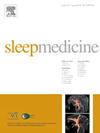Sex-specific differences in overnight nitrate levels in persons with obstructive sleep apnea and type 2 diabetes
IF 3.8
2区 医学
Q1 CLINICAL NEUROLOGY
引用次数: 0
Abstract
Study objectives
Sex-specific differences in OSA-associated symptoms and polysomnographic findings are well recognized. However, sex differences in intermediate pathways potentially linking OSA and cardiometabolic outcomes are limited. OSA is known to be associated with decreased nitric oxide (NO)-related vasodilation and endothelial dysfunction. The current study sought to characterize the independent association between OSA severity and overnight NO metabolites (i.e. markers of oxidative stress) and determine if there were differences by sex in persons with type 2 diabetes mellitus (T2DM).
Methods
Adults with T2DM and undiagnosed OSA were recruited from the community. Demographic information, an overnight polysomnogram, and pre- and post-sleep plasma samples were collected. The association between OSA and nitrite and nitrate levels were examined using multivariable linear regression. Analyses were done for the entire sample and stratified by sex.
Results
The sample included 83 participants with 52 % men. Stratified, fully adjusted models showed that compared to women with mild OSA, women with moderate or severe OSA did not exhibit the expected decline in overnight nitrate levels: 4.84 μM (−12.3, 2.7: p = 0.09) and 5.82 μM (−4.7, 16.3: p < 0.01) for moderate and severe OSA, respectively. Overnight nitrate levels decreased in males regardless of OSA severity, without significant differences across severity categories. An interaction between OSA severity and sex was seen for post-sleep nitrates in women with severe OSA.
Conclusion
The association between OSA and overnight nitrates varies by sex and OSA severity. Women with severe OSA did not have a decline in overnight nitrate levels whereas men did, suggesting they have higher overnight oxidative stress.
求助全文
约1分钟内获得全文
求助全文
来源期刊

Sleep medicine
医学-临床神经学
CiteScore
8.40
自引率
6.20%
发文量
1060
审稿时长
49 days
期刊介绍:
Sleep Medicine aims to be a journal no one involved in clinical sleep medicine can do without.
A journal primarily focussing on the human aspects of sleep, integrating the various disciplines that are involved in sleep medicine: neurology, clinical neurophysiology, internal medicine (particularly pulmonology and cardiology), psychology, psychiatry, sleep technology, pediatrics, neurosurgery, otorhinolaryngology, and dentistry.
The journal publishes the following types of articles: Reviews (also intended as a way to bridge the gap between basic sleep research and clinical relevance); Original Research Articles; Full-length articles; Brief communications; Controversies; Case reports; Letters to the Editor; Journal search and commentaries; Book reviews; Meeting announcements; Listing of relevant organisations plus web sites.
 求助内容:
求助内容: 应助结果提醒方式:
应助结果提醒方式:


